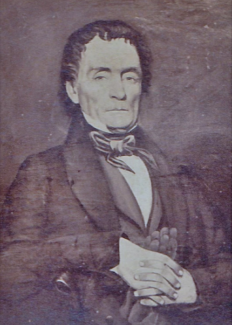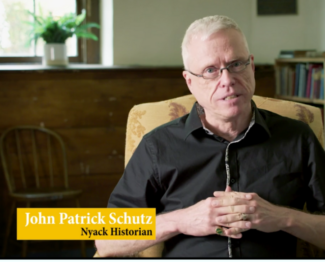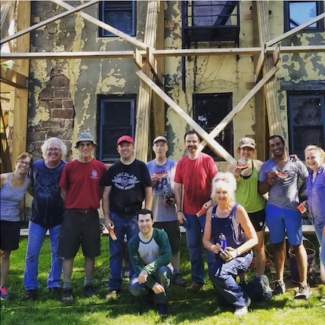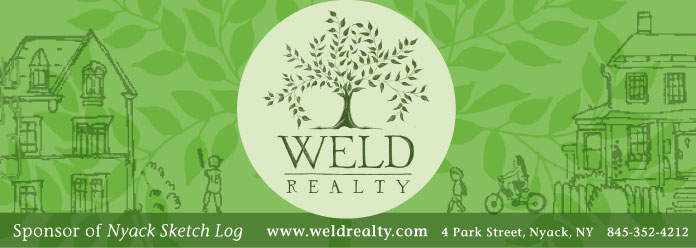The physical appearance and legal status of the John Green House has markedly improved since this 2012 Sketch Log illustration. Massive wooden beams hold the structure in place, as volunteers donate sweat equity, cleaning debris from the interior. And last month, the building was designated as an official Village of Nyack landmark.
On Wednesday, March 17, at 7p, Village of Nyack Historian JP Schutz will give a zoom based presentation about the man who erected the last of the stone houses in Nyack of the style built by the early settlers of Dutch ancestry, The Complicated Legacy of John Green.
Green’s impact endures from his role in many transformative projects that have shaped Nyack to this day. His legacy is complicated by the economic benefits reaped from the labor of enslaved Africans. JP will answer questions following his pre-recorded lecture. Coalition President Win Perry will participate in the discussion following the talk.
John Edward Green was born in 1772. After a fire consumed his lumber business in Coeymans, NY, he arrived in Nyack to start from scratch. His first job was as a laborer for the Cornelison family. Soon, he returned to the timber trade, opening his second lumberyard around 1810.
Green built this house at the bottom of Main Street in 1819. It still exhibits the distinct traditional  Dutch Colonial design with roughly coursed stone walls (now covered in stucco) and a high gambrel roof. The sandstone used for the walls was quarried a few miles north. Some of the original stones are visible where the stucco has been removed.
Dutch Colonial design with roughly coursed stone walls (now covered in stucco) and a high gambrel roof. The sandstone used for the walls was quarried a few miles north. Some of the original stones are visible where the stucco has been removed.
The Nyack of 1820 was an isolated outpost only accessible by dirt roads or the Hudson. Working with a member of the family that purchased the Tappan patent in 1687, Tunis Smith, Green championed 2 major transportation and infrastructure projects that literally put Nyack on the map.
Certainly self-interest figured in Green’s construction of Nyack’s first dock, where Hudson River sloops could deliver lumber for his yard. However, guided by a depth map of the shoreline drafted by Smith, Green inspired a transportation revolution when he helped form the Nyack Steam Boat Association. (A photographic copy Tunis’s 1825 drawing, possibly the earliest map of Nyack, can be seen at Hannemann’s Funeral Home.) Steamboats eventually replaced the sloop as the primary mode for passenger and freight transportation until the railroad came to Nyack in 1873.
The Complicated Legacy of John Green

Wednesday, March 17, 7p
Join Village of Nyack Historian John Patrick Schutz for a presentation the John Green.
Green’s impact endures from his role in many transformative projects that have shaped Nyack to this day. His legacy is complicated by the economic benefits reaped from the labor of enslaved Africans. JP will answer questions following his pre-recorded lecture. John Green Preservation Coalition President Win Perry will participate in the discussion following the talk.
Visit the event page of Nyack Library by clicking here to register.
The Armchair Tour is sponsored by the Historical Society of the Nyack and Nyack Library.
Nyack was now connected to the world through nature’s mighty highway, the Hudson. But once goods got to our shore, overland transportation was unreliable and arduous. The West Nyack Swamp, which still stymies the efforts of modern engineers, stopped any western progress. Inland travelers in the early 19th century could only turn north or south on Greenbush Road, which was then known as King’s Highway. There was no way to connect the iron foundry and machine shops of Ramapo to the Hudson River.
Once again the tag team of Smith and Green were called upon to apply their talents. Smith surveyed the route and in 1830 Green joined a state commission to oversee construction of the Nyack Turnpike, a road that roughly followed the course of what is now Route 59.
 In addition to these important public works, Green was an early trustee of the Nyack Library and a founding member of the Methodist Church, helping erect the Old Stone Meeting House on North Broadway. Green died on April 10, 1842, and is buried in Oak Hill Cemetery.
In addition to these important public works, Green was an early trustee of the Nyack Library and a founding member of the Methodist Church, helping erect the Old Stone Meeting House on North Broadway. Green died on April 10, 1842, and is buried in Oak Hill Cemetery.
As long as this house stands, we can touch this sandstone and have contact with materials that may have been handled by our anonymous slave ancestors. These stones, quarried from our soil, fueled an economy that was made possible by the bounty of our river, transforming a bunch of homesteads into a community that has survived centuries.
 This stone house holds together the many complex threads of a history that makes Nyack unique. As the oldest building in Nyack, it is a vessel for our collective memory. Sandstone may be obsolete as a building material, but for the role it has played in the development of our village, it is a precious stone. If the story of how our village came to be truly matters to us, we will find a way to save our Green House.
This stone house holds together the many complex threads of a history that makes Nyack unique. As the oldest building in Nyack, it is a vessel for our collective memory. Sandstone may be obsolete as a building material, but for the role it has played in the development of our village, it is a precious stone. If the story of how our village came to be truly matters to us, we will find a way to save our Green House.
An activist, artist and writer, Bill Batson lives in Nyack, NY. Nyack Sketch Log: “Nyack Sketch Log: Support the John Green House” © 2016 Bill Batson. Visit billbatsonarts.com to see more.










